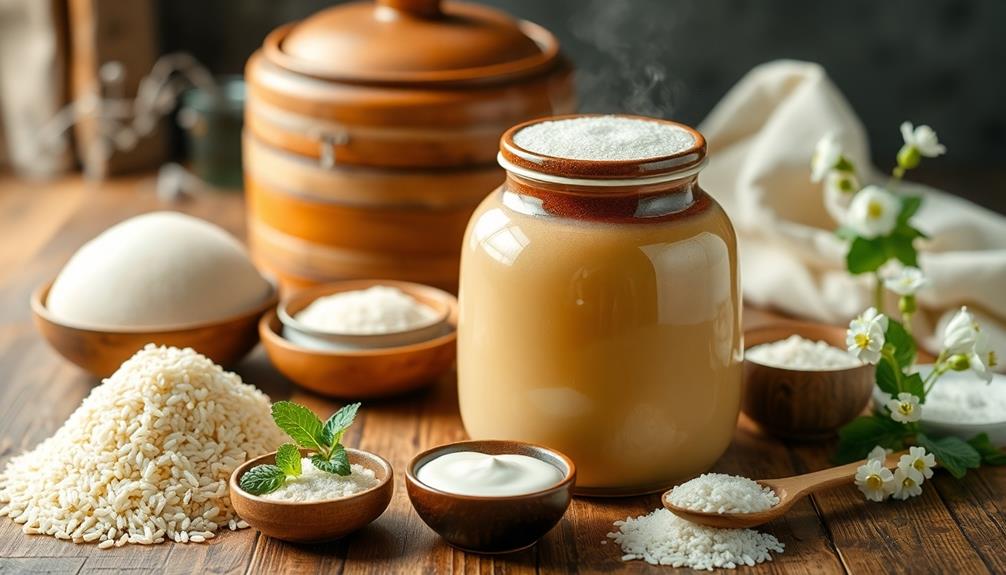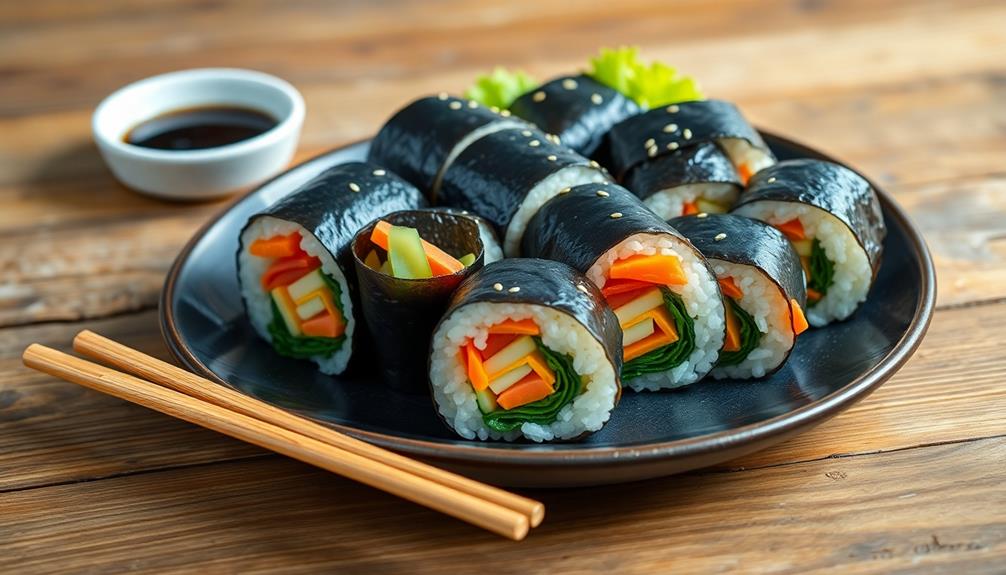Makgeolli is a fun, fizzy Korean rice wine that's been around for over a thousand years! It's made from short-grain rice, water, and a special fermentation starter called nuruk. You'll love how it brings people together at celebrations! The creamy texture and slightly sweet flavor make it super enjoyable. To make it, you soak the rice, blend it with nuruk, and let it ferment, watching for magical bubbles! Don't forget to taste as you go for the best flavor. If you want to discover more about the brewing process and its delicious history, you're in for a treat!
Key Takeaways
- Makgeolli is a traditional Korean rice wine with a history spanning over a thousand years, originating during the Goryeo Dynasty.
- The brewing process involves soaking short-grain rice, blending it with nuruk, and fermenting for 48 hours.
- Key ingredients include rice, water, nuruk, sugar, and salt, with quality significantly affecting the final taste.
- Makgeolli is known for its creamy texture and is believed to aid digestion and boost energy.
- It is best enjoyed fresh, enhancing social gatherings and celebrations, reflecting a rich cultural heritage.
History
Throughout history, people have enjoyed makgeolli, a traditional Korean rice wine that dates back over a thousand years. This delightful drink has roots in the Goryeo Dynasty, where it was often served at celebrations and special events. Today, makgeolli continues to be enjoyed at gatherings with friends and family, as well as being a popular choice at restaurants and bars. Many people also enjoy making their own homemade makgeolli, using traditional methods and recipes passed down through generations. In fact, some even use makgeolli as an ingredient in dishes such as the miyeok guk recipe, a traditional Korean seaweed soup.
Imagine a time when farmers would brew makgeolli in their homes, sharing it with family and friends after a long day of work. Doesn't that sound cozy?
As time went on, makgeolli became a staple in Korean culture. It was loved not just for its unique taste, but also for its health benefits. People believed it helped with digestion and boosted energy.
You might find it interesting that during the Joseon Dynasty, makgeolli makers were highly respected, almost like artists, as they carefully balanced ingredients to create the perfect brew.
Even today, many Koreans enjoy makgeolli at gatherings, festivals, or just a casual night in. It's often paired with delicious foods like pajeon, a savory pancake.
Recipe
Makgeolli, a traditional Korean rice wine, is known for its milky appearance and slightly sweet, tangy flavor. This fermented beverage is made from a combination of steamed rice, water, and a fermentation starter known as nuruk, which contains natural enzymes and yeast. Brewing makgeolli at home is a rewarding experience that connects you to Korean culture and its rich culinary heritage.
The process may seem daunting at first, but with a little patience and the right ingredients, you can create a delightful batch to enjoy with friends and family.
To start your makgeolli journey, it's essential to prepare the ingredients properly. The quality of the rice and water will significantly impact the final taste, so choose good-quality short-grain rice and filtered water if possible. After cooking, the rice should be cooled down to room temperature before adding the nuruk, as high temperatures can kill the yeast.
Allow the mixture to ferment in a warm, dark place for about a week, and you'll soon be rewarded with a delicious, homemade beverage that can be enjoyed chilled.
Ingredients:
- 2 cups short-grain rice
- 4 cups water (for cooking rice)
- 2 cups water (for fermentation)
- 1 cup nuruk (fermentation starter)
- 1/4 cup sugar (optional, for sweetness)
- 1/2 teaspoon salt (optional)
Instructions:
Start by rinsing the short-grain rice under cold water until the water runs clear, then soak it in water for about 4 hours. After soaking, drain the rice and steam it for 30-40 minutes until fully cooked.
Allow the rice to cool to room temperature, then transfer it to a large bowl. Add the nuruk and the 2 cups of water, mixing well until everything is combined. If desired, stir in sugar and salt for added flavor.
Cover the bowl with a clean cloth, place it in a warm area, and let it ferment for about 5-7 days, stirring once a day to help with the fermentation process. Once the fermentation period is complete, strain the mixture through a cheesecloth to separate the liquid from the solids. The liquid is your makgeolli, which can be bottled and stored in the refrigerator.
Extra Tips:
When brewing makgeolli, ensure that all your utensils and containers are thoroughly cleaned to prevent unwanted bacteria from interfering with the fermentation process.
The fermentation time can vary depending on the temperature; warmer environments may speed it up while cooler areas will slow it down. Taste your makgeolli periodically during the fermentation process to achieve your desired flavor profile.
Lastly, remember to shake or stir the makgeolli gently before serving, as it can separate during storage, and enjoy it fresh for the best experience!
Cooking Steps
Ready to make some delicious makgeolli?
First, you'll soak the rice overnight, which is like giving it a cozy bath before the fun begins!
Then, you'll blend it with a fermentation starter, and after a couple of days of patiently waiting, you'll see your mixture transform into something truly special.
Step 1. Soak Rice Overnight
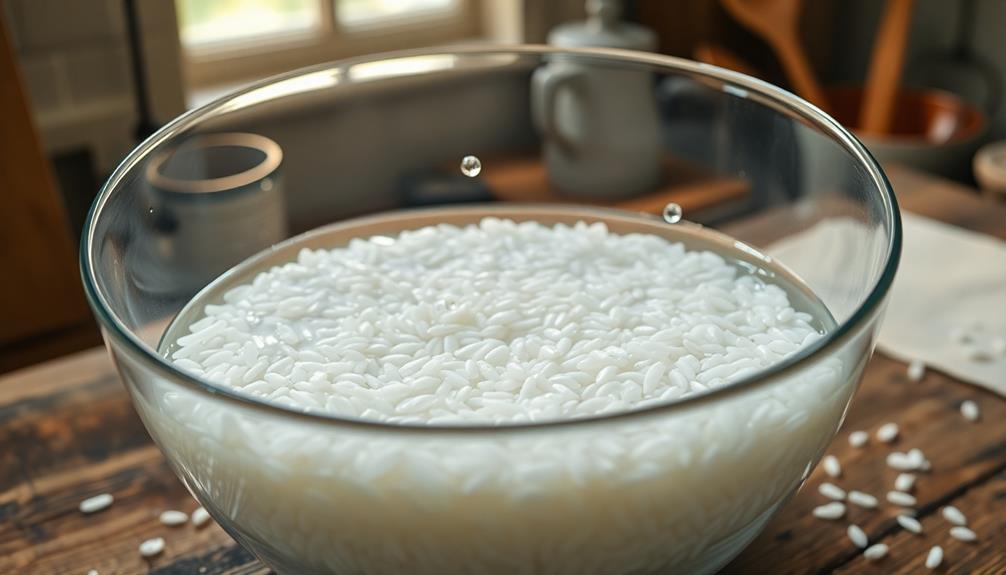
To create the perfect base for your makgeolli, start by soaking the rice overnight. This step is super important because it helps the rice absorb water, making it soft and ready for the next steps.
Grab about two cups of sweet rice, also called "chapssal," which is a little stickier than regular rice. Rinse the rice under cold water several times until the water runs clear. This washes away any dust or extra starch, giving you a cleaner taste!
After rinsing, place the rice in a bowl and cover it with enough water, letting it soak for at least eight hours. You can do this before bed and then dream of delicious homemade makgeolli!
In the morning, drain the rice and let it sit for a bit to dry. This little bit of patience pays off, as the rice will be just right for blending later.
If you forget to soak it overnight, don't worry! You can soak it for just a few hours, but the overnight soak really makes a difference.
Step 2. Blend With Fermentation Starter
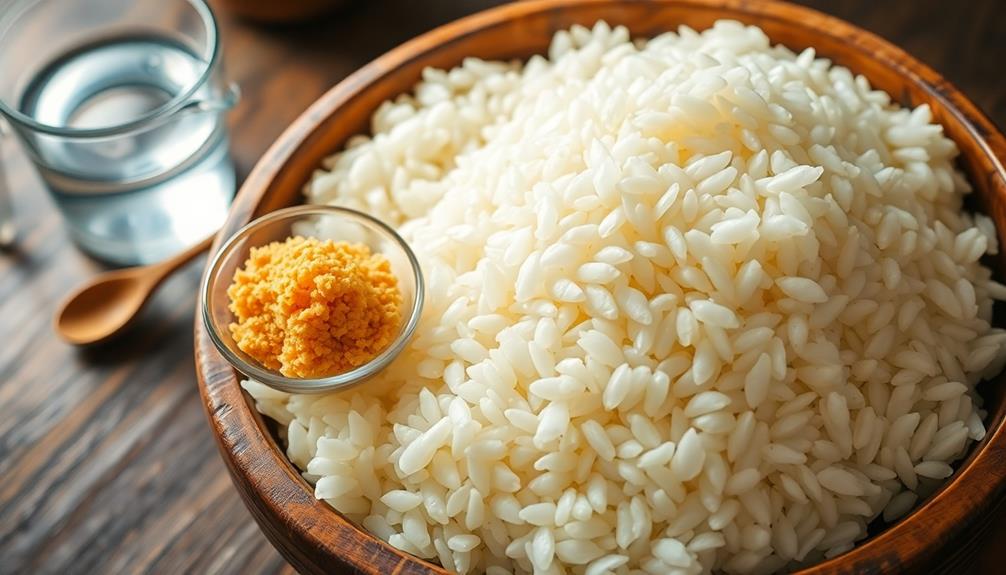
After soaking the rice, it's time to blend it with the fermentation starter. You'll want to gather your ingredients, including the soaked rice and the fermentation starter, called nuruk. This magical powder helps turn your rice into delicious makgeolli!
First, drain the soaked rice and let it sit for a minute to dry out a bit. Then, place the rice in a large mixing bowl. Next, sprinkle the nuruk over the rice.
Now, get your hands in there—mix everything together! You can gently squeeze the rice and nuruk, making sure they combine well. This part is super important because it helps the fermentation process get started.
As you mix, you might notice the rice becoming a bit sticky—that's just part of the fun! Keep blending until the nuruk is evenly distributed, and try to break up any clumps of rice. You want it nice and fluffy, not lumpy.
Once you're done, it's time to prepare for the next big step in making your homemade rice wine. So, roll up your sleeves, enjoy this mixy moment, and get ready to watch your creation come to life!
Step 3. Ferment Mixture for 48 Hours
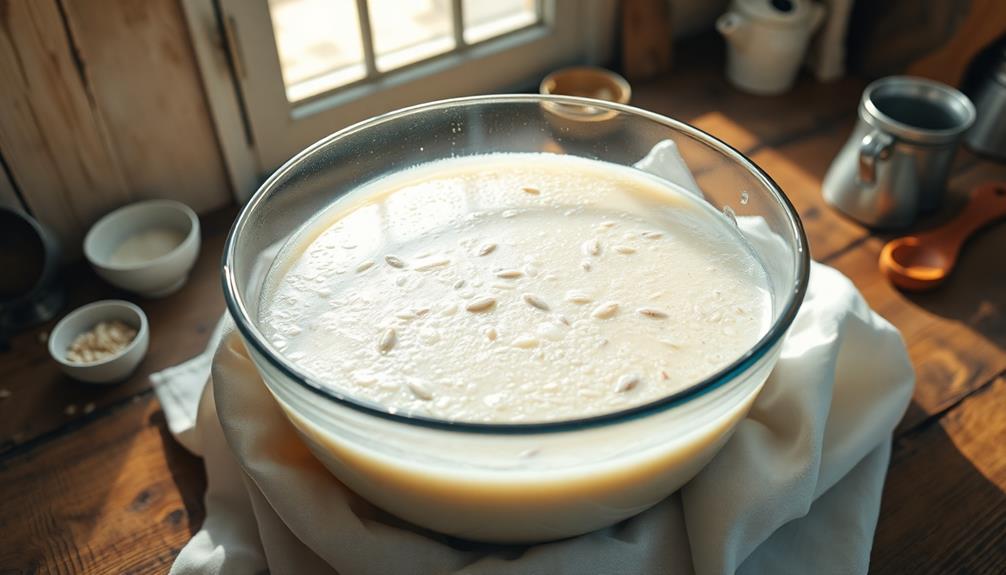
With the rice and nuruk mixture well combined, it's time to let fermentation work its magic.
Find a cozy spot in your kitchen, away from direct sunlight, and place your mixture in a large container. You want it to be a bit warm but not too hot—think of a sunny day, just right for a picnic! Cover the container loosely with a clean cloth or lid to let air circulate.
Now, here comes the exciting part! Over the next 48 hours, watch as tiny bubbles form, and the mixture starts to smell a bit sweet and yeasty.
That means it's alive and kicking! Don't worry if it looks a bit lumpy; that's all part of the fun. Your mixture is busy transforming into something special.
Make sure to check on it every now and then; you might even want to give it a gentle stir to help things along.
After two days, you'll notice a change in texture and aroma, and you'll be ready to move on to the next step.
You're one step closer to making your very own makgeolli—how cool is that?
Step 4. Strain Mixture Through Cheesecloth

The bubbling mixture is now ready for the next crucial step: straining it through cheesecloth. This is where the magic happens!
First, grab a large bowl to catch all the liquid goodness. Then, take a clean piece of cheesecloth, and fold it several times to make it nice and thick. Place the cheesecloth over the bowl, ensuring it hangs down the sides a bit, like a cozy blanket.
Now, carefully pour the fermented mixture onto the cheesecloth. You might see some clumps or solids—don't worry! That's just the rice and fermentation goodies. As the liquid flows through, give the mixture a gentle stir with a spoon to help it along. You'll feel like a scientist in a lab, creating something amazing!
Once most of the liquid has drained, gather the edges of the cheesecloth and lift it up, letting any remaining liquid drip into the bowl. You can even squeeze it a little, but be careful not to make a mess!
Now you've got your beautiful, strained makgeolli ready for the next step. Isn't that exciting? You're one step closer to enjoying your homemade rice wine!
Step 5. Add Sweetener to Taste

Now that you've got your beautifully strained makgeolli, it's time to enhance its flavor by adding sweetener to taste. This step is all about making your delicious drink even yummier! You can choose between sugar, honey, or even maple syrup. Each option brings its own unique twist to the flavor, so feel free to experiment.
Start by adding a small amount, about one tablespoon, and stir it well into the makgeolli. Remember, you can always add more, but it's tough to take sweetness away!
Once it's mixed in, give it a taste. If it's not sweet enough for you, sprinkle in some more and stir again. Keep tasting until you find just the right level of sweetness that makes your taste buds dance!
Don't forget, sweetening your makgeolli is like putting on the perfect accessory—it completes the drink!
You might even want to serve it chilled, which can make the sweetness pop even more. So, grab your glass, make it just the way you like, and enjoy this delightful, homemade rice wine with friends or family. Cheers to your delicious creation!
Final Thoughts
As you explore the world of makgeolli, you'll discover not just a unique beverage but also a rich cultural heritage. This traditional Korean rice wine, with its creamy texture and slightly sweet taste, is more than just a drink; it's a connection to history and community.
When you sip on makgeolli, you're joining in a tradition that spans centuries, made with love and care.
Making your own makgeolli can be a fun adventure! With just a few ingredients, like rice and nuruk, you can create something special to share with friends and family.
You'll enjoy the process, from watching the fermentation bubbles to tasting your creation. And remember, you can always adjust the sweetness to suit your taste.
Whether you're enjoying it on a warm day, at a celebration, or just relaxing at home, makgeolli brings joy to any occasion.
So, why not give it a try? Dive into this delightful experience, and you'll find that each sip is a little celebration of culture and flavor.
Cheers to your makgeolli journey!
Frequently Asked Questions
What Is the Alcohol Content of Makgeolli?
The alcohol content of many traditional beverages varies between 6% to 20%. You should check the specific drink's label or ask for details to know exactly how much alcohol it contains before consuming.
Can Makgeolli Be Stored for Long Periods?
You can store it for a while, but its freshness diminishes over time. Ideally, consume it within a few weeks for the best flavor. Refrigeration helps, but long-term storage isn't recommended for optimal taste.
Is Makgeolli Gluten-Free?
You'll find that not all rice wines are gluten-free. If you're concerned about gluten, check the ingredients carefully, as some brands may use additives that contain gluten. Always opt for certified gluten-free options when possible.
What Are Common Pairings With Makgeolli?
When enjoying this beverage, you'll find it pairs wonderfully with savory pancakes, spicy dishes, or fried foods. These combinations enhance the flavors, creating a delightful experience that complements the drink's unique characteristics and texture.
How Is Makgeolli Traditionally Served?
Traditionally, it's served in a bowl or a small cup, often accompanied by a ladle for pouring. You'll notice it's usually enjoyed chilled, enhancing its refreshing qualities and making it perfect for social gatherings.
